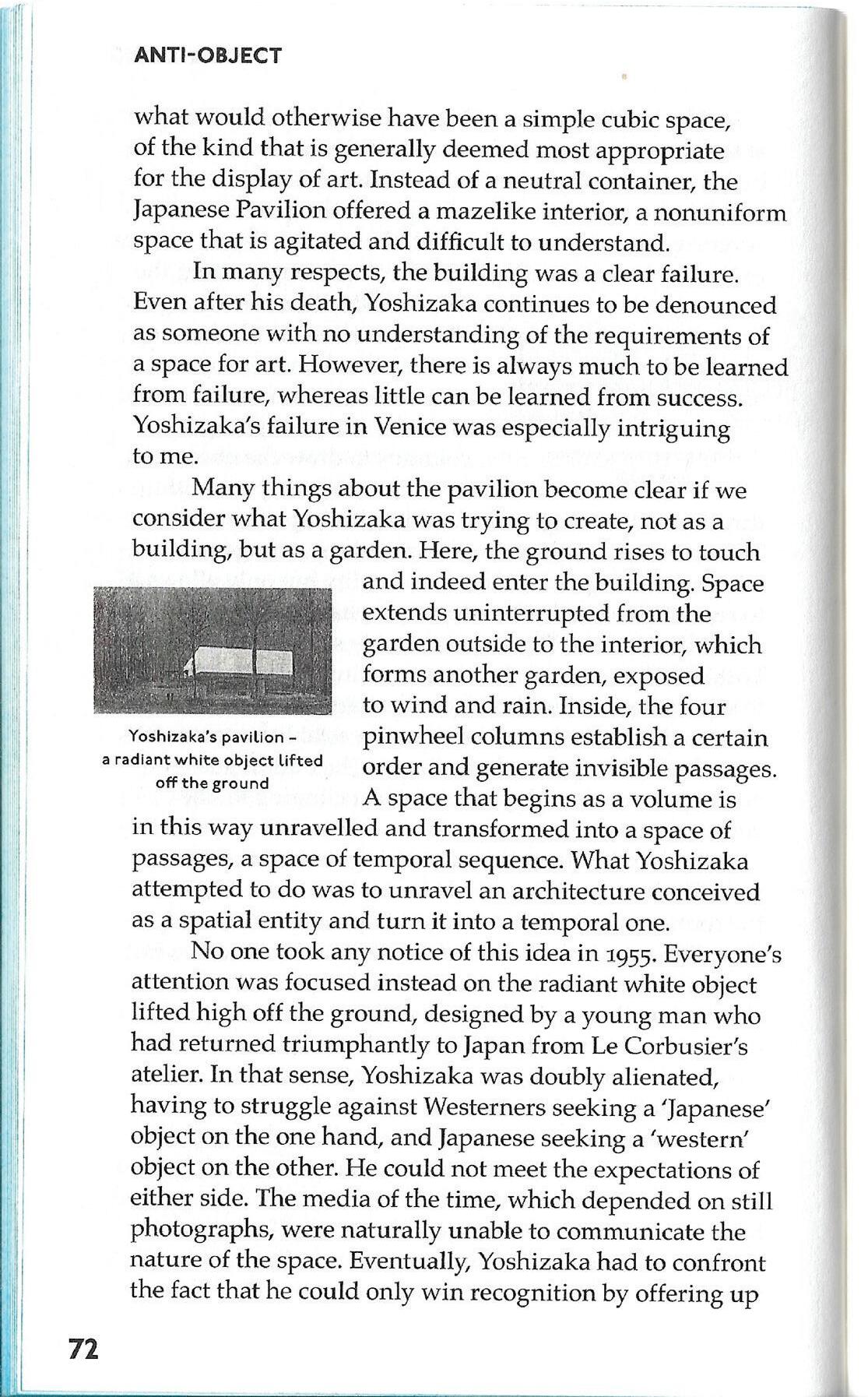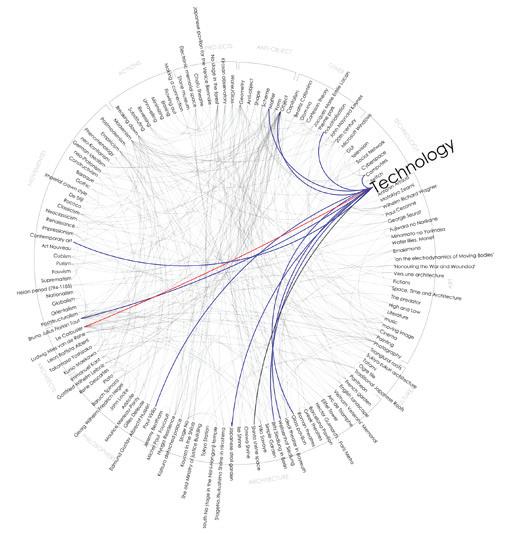ANTI-OBJECT*
Architecture Words 2
Anti-Object: The Dissolution and Disintegration of Architecture
Kengo Kuma
Translated by Hiroshi Watanabe
London 2008, Architectural Association
18 x 11 cm, illustrated, 152 pp. Paperback
ISBN 978-1-902902-52-4








Architecture Words 2
Anti-Object: The Dissolution and Disintegration of Architecture
Kengo Kuma
Translated by Hiroshi Watanabe
London 2008, Architectural Association
18 x 11 cm, illustrated, 152 pp. Paperback
ISBN 978-1-902902-52-4







- Anti-/ prefix/,an-,ti, ,an-te also ,an-ti before consonsants \ variants: or ant- or anth-
1a: of the same kind but situated opposite, exerting energy in the opposite direction, or pursuing an opposite policy
1b: one that is opposite in kind to
2a: opposing or hostile to in opinion, sympathy, or practice
2b: opposing in effect or activity
3: serving to prevent, cure, or alleviate
4: combating or defending against
5: being or composed of antimatter
- Object /noun / ob·ject | \ ab-jikt
1a: something material that may be perceived by the senses
1b: something that when viewed stirs a particular emotion (such as pity)
2a: something mental or physical toward which thought, feeling, or action is directed
2b: something physical that is perceived by an individual and becomes an agent for psychological identification
3a: the goal or end of an effort or activity: purpose, objective
3b: a cause for attention or concern
4: a thing that forms an element of or constitutes the subject matter of an investigation or science
5a: a noun or noun equivalent denoting the goal or result of the action of a verb (such as ball in I hit the ball)
5b: a noun or noun equivalent in a prepositional phrase (such as table in on the table)
6a: a data structure in object-oriented programming
6b: a discrete entity in computer graphics that can be manipulated independently of other such entities
2α:
3:
4:
5:
9:
anti-object, Kengo Kuma, διάγραμμα, Bruno Taut,
The subject of the following research is the visualization of the book entitled “ANTI-OBJECT”, by the architect Kengo Kuma, through a diagrammatic analysis. The book is a theoretical text approaching architecture through philosophical, artistic and historical references, with the most important of all, the architect Bruno Taut. At the same time the architect himself, presents seven (7) of his own projects where in each of them he uses a different approach that will lead him to an aesthetic of disappearance, pointing out that technology can contribute to the creation of an alternative form of architecture. Having as primary material the references of the book, the research was developed through a sequence of diagrams based on the quantitative and qualitative visualization of the data. The fundamental goal of the research is to formulate conclusions in the form of questions, which arise from the interpretation of the diagrams as an objective for further investigation.
Keywords: anti-object, Kengo Kuma, diagrams, Bruno Taut, technology, architectural dissolution
Kengo Kuma.
https://www.zak.group/projects/architecture-words
3. Kuma, Kengo, 2008, Anti-object,
4. Ό.π, Kuma, 2008, preface
5. Ό.π, Kuma, 2008, preface
6. Boyd, Gary, Keeffe, Greg, 2015, MNI: Motorway Notation network, Belfast, Queen’s Architectural Press, abstract
7.Kuma, Kengo, 2008, Anti-object,
‘Water/Glass’ , το ‘Kirosan Observatory’, το ‘No Stage in the forest’, το ‘Japanese Pavilion for the Venice Biennale’, το ‘Chofu Theatre’, το ‘Electronic Memorial space’ και το ‘Stone Museum’ 12
‘Flowing out’, ‘Erasing’, ‘Minimising’, ‘Unravelling’, ‘Reversing’, ‘Substituting’ και ‘Breaking down into particles’.
Kengo Kuma
8. Ό.π, Kuma, 2008, σελ.2
9.
10.
11.
12. ‘Water/Glass’, Atami, Shizuoka, 1992-95, ‘Kirosan Observatory’, Ochi-Gun, Ehime, 1991-94, ‘No Stage in the forest’, Tomoya, Miyagi, 1995-96, ‘Japanese Pavilion for the Venice Biennale’, 1995, ‘Chofu Theatre’, Tokyo, 1997, ‘Electronic Memorial space’, Takasaki, Gumma, 1997-98, ‘Stone Museum’, Nasu-cho, Tochigi, 1996-2000
13.
15. Zagorisios, Athanasios. 2006. The Anti-Object: On the Presence of Architectural Form A Comparative Research between Japan and the West. Kyoto: Research in Kyoto University Department of Architecture, Kiyoshi Sey Takeyama Lab. 16. Ό.π. Ρεπούσκου. 2005.
17. Lippard, Lucy. 1973. Six years: the dematerialization of the art object from 1966 to 1972; a cross-reference book of information on some esthetic boundaries. New York: Praeger.
18.
Ό.π. Ζαγορίσιος, 2015.
22. Ό.π. Zagorisios, 2006.
23. Daniel, Thomas. 2008. After the Crash: Architecture in Post-Bubble Japan. New York: Princeton Architectural Press, σελ. 21.
24. Ό.π. Zagorisios, 2006
25. https://el.wikipedia.org/wiki/%CE%94%CE%B9%CE%AC%CE%B3%CF%81%CE%B1%CE%BC%CE%BC%CE%B1?fbclid=IwAR04qQtlusetUMC_6wtp0n1u1s9vGC6wWPt5Q5m-GG1AVVKc0v3UVWxd8B4
26. https://guides.auraria.edu/c.php?g=528873&p=3964258
“Οur objective should not be to renounce matter but rather to search for a form of matter other than objects. What that form is called – architecture, gardens, computer technology–is not important. Until a new name is given to that form, I will call it the ‘anti-object”.28











Le Corbusier, o Mies Van de Rohe, η













Bruno Taut, Le Corbusier,











PROJECTS
-The Hyuga residence
-Water/Glass -95, -Kirosan observatory
-No stage in the forest -Japanese pavilion,Venice Bienale -Chofu Theatre
-Electronic memorial space -Stone museum
ACTIONS
-Make a/the connection -Flowing out -Erasing -Minimizing -Unravelling -Reversing -Substituting -Breaking down
Stijl
-Bruno Julius Florian Taut
-Le Corbusier
-Leon Battista Alberti
-Ludwig Mies van de Rohe
Ιάπωνες
-Kunio Maekawa
-Takamasa Yoshizaka ΦΙΛΟΣΟΦΟΙ
-Baruch Spinoza
-Edmund Gustav Albrecht
-Husserl
-Georg Wilhelm Friedrich Hegel
-Gilles Deleuze
-Gottfried Wilhelm Leibniz
-Immanuel Kant
-Jeremy Bentham
-John Locke
-Maurice Merleau-Ponty
-Michel-Paul Foucault
-Paul Virilio
-Rene Descartes
-Αριστοτέλης
-Πλάτωνας
-Hyuga Residence
-Katsura detached palace
Δημόσια
-Itsukushima Shrine No Stage in Hiroshima
-south No stage in the NishiHonganji temple
-Stage No
-The old Ministry of justice
Building
-Tokyo Station Κήποι
Ise
Omiwa
-Britz Siedlung
-Villa Savoye
-Weissenhof Siedlung
Δημόσια
-Glass pavilion
Κήποι
ΠΟΛΙΤΙΣΤΙΚΑ
Πάτωμα -Tatami
Ακμές -Sukiya- zukuri architecture
Δύση Οροφές
ΤΕΧΝΕΣ
-Κινούμενη εικόνα -Λογοτεχνία -Μουσική -Φωτογραφία
Ταινίες -High and Low, Akira Kurosawa -The predator, John Mc Tiernan
Βιβλία -Fictions, Jorge Luis Borges -space, time and architecture, Sigfried Giedion
Δοκίμια -‘on the electrodynamics of Moving Bodies’ -Vers une architecture
Πίνακες
Emakimono
Water lilies, Monet
Ποιητές
-Fujiwara no Norikane
-Minamoto no Yorimasa
Ζωγράφοι
-George Seurat
-Paul Cezanne
Συνθέτες
-Wilhelm Richard Wagner
Ηθοποιοί
-Antoine Marie Joseph Paul Artaud
-Motokiyo Zeami
ΤΕΧΝΟΛΟΓΙΑ
-GUI
-Microsoft Windows
ANTI-OBJECT
-Beatriz Colomina
-Dom-ino
-Jacques Marie Emile Lacan
-John Maynard Keynes
The Hyuga residence by Bruno Taut, Atami, Japan, 1936 Water/Glass by Kengo Kuma, Atami, Shizuoka, 1992-95, Kirosan observatory by Kengo Kuma, Ochi-Gun, Ehime, 1991-94, No stage in the forest by Kengo Kuma, Tomoya, Miyagi, 1995-96, Japanese pavilion for the Venice Biennale by Kengo Kuma, 1995, Chofu Theatre by Kengo Kuma, Tokyo, 1997, Electronic memorial space by Kengo Kuma, Takasaki, Gumma, 1997-98, Stone museum by Kengo kuma, Nasu-Cho, Tochigi, 1996-2000,
Make a/the connection / idiom
1:to understand that there is a relationship between two or more things
Flowing out (flow out)/ verb
1. To rush out of something, as of a liquid.
2. By extension, to move or spill quickly out of someone in a fluid, effortless manner
3. To move quickly out of some place or thing in large numbers.
Erasing (erase) / transitive verb / i-’ras (British -’raz)
1a: to rub or scrape out (something, such as written, painted, or engraved letters)
1b: to remove written or drawn marks from
1c: to remove (recorded matter) from a magnetic medium
1d: to delete from computer storage
2a: to remove from existence or memory
2b: to nullify the effect or force of sth
Minimizing (minimize)/ transitive verb / min·i·mize | ‘mi-ne-,miz
1: to reduce or keep to a minimum
2: to underestimate intentionally
3: to replace (a window) on a computer display with a small button or icon which will restore the window when selected
Unravelling (unravel) / transitive verb / un·rav·el | \ ,en-’ra-vel
1a: to disengage or separate the threads of : DISENTANGLE
1b: to cause to come apart by or as if by separating the threads of 2: to resolve the intricacy, complexity, or obscurity of : clear up
Reversing (reverse) / transitive verb / re·verse | \ ri-’vers
1a: to turn completely about in position or direction
1b: to turn upside down
1c: to cause to take an opposite point of view
2a: to overthrow, set aside, or make void (a legal decision) by a contrary decision
2b: to change to the contrary
2c: to undo or negate the effect of (something, such as a condition or surgical operation)
3: to cause to go in the opposite direction
Substituting (substitute) / transitive verb / sub·sti·tute | \ s b-st - t t , - ty t
1a: to put or use in the place of another
1b: to introduce (an atom or group) as a substituent
2: to take the place of: REPLACE
Breaking down / transitive verb / break·down | \ br k- dau n
1a: to cause to fall or collapse by breaking or shattering
1b: to make ineffective
2a: to divide into parts or categories
2b: to separate (something, such as a chemical compound) into simpler substances
2c: to take apart especially for storage or shipment and for later reassembling
Breaking down into / idiom
1: to separate (something) into (simpler substances)
2: to become separated into simpler substances
3: to divide (something) into (parts or groups)
4: to be able to be divided into parts or groups
Gottlieb Fichte, ο Friedrich Wilhelm Joseph Schelling, ο Arthur Schopenhauer και ο Georg Wilhelm
Friedrich Hegel.
Montparnasse)
Edouard Jeanneret (Le Corbusier).
Ozenfant
Julius Florian Taut: (1880-1938),
Takasaki, Gunma,
Le Corbusier: (Charles-Edouard Jeanneret 1887-1965),
Ueno,
Behrens,
Gropius.
Leon Battista Alberti: (1406-1472),
(1460)
(1472),
Ludwig Mies van de Rohe: (1886-1969)
Aalto, Le Corbusier, Walter Gropius
Bauhaus
Kunio Maekawa: (1905-1986)
Bunka Kaikan building,
(Tokyo Imperial University)
Takamasa Yoshizaka: (1917-1980),
Discontinuous Unity.
Baruch Spinoza: (1632-1677)
Edmund Gustav Albrecht Husserl: (1859-1938),
Gilles Deleuze: (1925-1995)
Anti-Oedipus (1972) και A Thousand Plateaus (1980).
Difference and Repetition (1968)
Deleuze
Kant,
Gottfried Wilhelm Leibniz:
Bergson,
Stoics,
Leibniz,
Rene Descartes
Immanuel Kant: (1724-1804)
Jeremy Bentham: (1747-1832)
John Locke: (1632-1704)
Maurice Merleau-Ponty: (1908-1961)
Michel-Paul Foucault: (1926-1984)
Paul Virilio: (1932-2018),
Rene Descartes: (1596 -1650),
Descartes
Spinoza
Leibniz,
Hobbes, Locke, Berkeley,
Itsukushima Shrine No Stage in Hiroshima: Noh
South No stage in the Nishi- Honganji temple:
Nishi Honganji
The old Ministry of justice Building:
Kasumigaseki
Chiyoda,
Hermann Ende
Tokyo Station:
miegakure
Outer Shrine, Geku,
Omikami,
Wilhelm Bockmann.
Britz Siedlung:
Hufeisensiedlung
Savoye:
Weissenhof Siedlung: Το Weissenhofsiedlung
Deutscher Werkbund,
Werkbundsiedlung,
Mies van der Rohe,
Glass pavilion:
Hubert Robert, Claude Lorrain
Nicolas Poussin,
Jean-Jacques Rousseau.
Πάτωμα
Sukiya-
High and Low, Akira Kurosawa, 1963:
Akira Kurosawa, με
Toshiro Mifune, Tatsuya Nakadai
Kyoko Kagawa. Η
The predator, John Mc Tiernan:
John McTiernan
(Kevin Peter Hall),
Fictions,
se bifurcan).
Ficciones. Ο Borges
The Garden of Forking Paths.
Space, time and architecture, Sigfried Giedion:
Sigfried Giedion
‘on the electrodynamics of Moving Bodies’, Einstein:
Annalen der Physik (Annals of Physics),
Vers une architecture, Le Corbusier:
Water lilies, Monet:
Monet (1840-1926).
Fujiwara no Norikane: (1107–1165)
Thirty Six Women Poetic Geniuses
Poetry Tournament of Thirty-Six Women Poetic Geniuses.
Minamoto no Yorimasa: (1106–1180)
George Seurat: (1859-1891)
A Sunday Afternoon on the Island of La Grande Jatte (1884-1886)
Paul Cezanne: (1839-1906)
Wilhelm Richard Wagner: (1813-1883)
Bayreuth Festspielhaus,
Festspielhaus,
Gottfried Semper, τις
Antoine Marie Joseph Paul Artaud: (1896-1948),
Motokiyo
ANTI-OBJECT
Dom-ino:
Jacques Marie Emile Lacan: (1901-1981)
John Maynard Keynes, 1st Baron Keynes: (1883-1946)
Poullain
Barre, Nicolas Malebranche και Baruch Spinoza.
Descartes
(Κατεύθυνση Α’).
-Boyd, Gary, Keeffe, Greg, 2015, MNI: Motorway Notation network, Belfast, Queen's Architectural Press, abstract
-Charles Jencks,2000, “Jencks’s Theory of Evolution: an overview of twentieth-century architecture”. Architectural Review, 76-79
-Daniel, Thomas. 2008. After the Crash: Architecture in Post-Bubble Japan. New York: Princeton Architectural Press.
-Kuma, Kengo, 2008, Anti-object,
Architectural Association London
Hiroshi Watanabe,
-Lippard, Lucy. 1973. Six years: the dematerialization of the art object from 1966 to 1972; a crossreference book of information on some esthetic boundaries. New York: Praeger.
-Zagorisios, Athanasios. 2006. The Anti-Object: On the Presence of Architectural Form A Comparative Research between Japan and the West. Kyoto: Research in Kyoto University Department of Architecture, Kiyoshi Sey Takeyama Lab.
-https://www.greek-language.gr/greekLang/index.html
-https://www.merriam-webster.com/
- https://www.zak.group/projects/architecture-words
- https://en.wikipedia.org/wiki/Main_Page
- https://guides.auraria.edu/c.php?g=528873&p=3964258
- https://think.design/services/data-visualization-data-design/treemap/
- http://www.visualcomplexity.com/vc/
-https://www.interaction-design.org/literature/article/how-to-design-an-information-visualization
- https://www.researchgate.net/figure/Published-in-Charles-Jencks-article-Jenckss-Theory-ofEvolution-an-overview-of_fig1_338555839